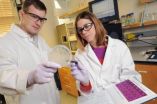(Press-News.org) A smoking gun in lung cancer epigenetics
Recent studies have identified correlations between cigarette smoke-induced microRNA (miRNA) expression and different aspects of lung cancer; however, it is unclear how miRNA expression directly contributes to carcinogenesis. MiRNAs regulate the expression of target genes and can have a significant impact on when and how well different gene products are expressed. In this issue of the Journal of Clinical Investigation, David Schrump and colleagues at the National Cancer Institute in Bethesda, MD, measured miRNA expression in normal human lung cells exposed to cigarette smoke condensate (CSC) and lung cancer cells derived from smokers and non-smokers. They found that CSC exposure repressed the miRNA-487b. Loss of miRNA-487b increased the expression of five critical oncogenes and enhanced the proliferation, invasion, tumorigenicity, and metastatic capacity of lung cells. Loss of miRNA-487b and concomitant up-regulation of the five oncogenes was also observed in patient lung cancer specimens. These results reveal a direct mechanism by which cigarette smoke-induced miRNA alterations promote lung carcinogenesis.
TITLE:
Cigarette smoke mediates epigenetic repression of miR-487b during pulmonary carcinogenesis
AUTHOR CONTACT:
David Schrump
National Cancer Institute, Bethesda, MD, USA
Phone: 301-496-2128; E-mail: david_schrump@nih.gov
View this article at: http://www.jci.org/articles/view/61271?key=1f628155b6680108ff1a
Researchers identify a factor that may contribute to increased heart attack-related mortality in diabetics
Diabetic patients are more than twice as likely to die from a heart attack as non-diabetic patients, but the mechanisms that underlie increased heart attack-related mortality in diabetic patients are unknown. High levels of the oxidized form of the protein CamKII (ox-CaMKII) have been linked to increased risk of sudden death after heart attack. Additionally, hearts from diabetic patients have significantly greater ox-CAMKII compared to hearts from non-diabetic patients. In this issue of the Journal of Clinical Investigation, Min Luo and colleagues at the University of Iowa used a mouse model of diabetest to determine if ox-CAMKII was an essential component of the molecular pathway that increases heart attack-related mortality in diabetic patients. The transgenic mouse model was engineered to express a form of CaMKII that cannot be oxidized in the heart muscle. Luo and colleagues found that diabetic mice expressed the non-oxidizable form of CamKII were less likely to die after a heart attack than mice that expressed normal CamKII. These findings suggest that ox-CAMKII may also increase post-heart attack mortality in diabetic patients and indicate that therapies that reduce oxidation of CamKII could be useful in treating diabetic patients who suffer from cardiovascular disease.
TITLE:
Diabetes increases mortality after myocardial infarction by oxidizing CaMKII
AUTHOR CONTACT:
Min Luo
University of Iowa Hospitals & Clinics, Iowa city, IA, USA
Phone: 319-356-2745; Fax: 319-356-8608; E-mail: min-luo-1@uiowa.edu
View this article at: http://www.jci.org/articles/view/65268?key=092be585f593debb00e1
ALSO IN THIS ISSUE
TITLE:
Depletion of FOXP3+ regulatory T cells promotes hypercholesterolemia and atherosclerosis
AUTHOR CONTACT:
Goran Hansson
Karolinska Institutet, Stockholm, SWE
Phone: 08-517-762-22; Fax: 46-8-313147; E-mail: Goran.Hansson@ki.se
View this article at: http://www.jci.org/articles/view/63891?key=c1df843db2cf77228eea
TITLE:
Mitochondrial Complex I activity and NAD+/NADH balance regulate breast cancer progression
AUTHOR CONTACT:
Brunhilde Felding-Haberman
Scripps Research Institute, La Jolla, CA, USA
Phone: 858-784-2021; E-mail: brunie@scripps.edu
View this article at: http://www.jci.org/articles/view/64264?key=790b11e14555fb86bf85
TITLE:
IL-6 trans-signaling promotes pancreatitis-associated lung injury and lethality
AUTHOR CONTACT:
Hana Algul
Technical University of Munich, Munich, DEU
Phone: 49-89-41406792; E-mail: hana.alguel@lrz.tum.de
View this article at: http://www.jci.org/articles/view/64931?key=5cdcf8375cd08827aa82
TITLE:
Hypoxia-responsive miRNAs target argonaute 1 to promote angiogenesis
AUTHOR CONTACT:
John Y-J. Shyy
University of California, Riverside, Riverside, CA, USA
Phone: 951-827-3863; Fax: 951-827-5504; E-mail: john.shyy@ucr.edu
View this article at: http://www.jci.org/articles/view/65344?key=5fab53e050196df9d18b
TITLE:
ERG induces androgen receptor-mediated regulation of SOX9 in prostate cancer
AUTHOR CONTACT:
Steven Balk
Beth Israel Deaconess Medical Center, Boston, MA, USA
Phone: 617-735-2065; Fax: 617-735-2050; E-mail: sbalk@bidmc.harvard.edu
View this article at: http://www.jci.org/articles/view/66666?key=ebfd1fb6b15a5fd9a7ea
###
END
In the most comprehensive report in a half century, experts today described fundamental changes needed in the education of the scientists whose work impacts medicine, drug discovery and virtually every other discipline. The result of a year-long project of a presidential commission of the American Chemical Society (ACS), the world's largest scientific society, the report was the topic of a symposium here at the 2013 annual meeting of the American Association for the Advancement of Science (AAAS).
Although it concluded that the state of graduate education in the chemical ...
From sore feet to backaches, blame it on human evolution.
"Because we are the only mammals to walk on two feet," says Bruce Latimer, an anthropologist from the Case Western Reserve University School of Dental Medicine.
Latimer will present "A Backache of Longstanding: An Evolutionary Perspective on the Human Vertebral Column" at the 2013 American Association for the Advancement of Science's annual meeting in Boston, Feb. 14-18. His talk will be featured in the session, "The Scars of Human Evolution."
Latimer and other panelists will explain how adapting to upright ...
BOSTON - The notion of "personalizing" health care through the use of an individual's genetic code has attracted considerable enthusiasm and investment. Impressive examples, confirmed through formal studies of clinical validity and utility, suggest that we have only scratched the surface of applications to treat disease more precisely, identify risk factors for complex disease, and guide preventative measures.
As the cost of sequencing entire genomes falls, the opportunities for people around the world to take possession of their entire genetic code will proliferate. ...
When it comes to healing the terrible wounds of war, success may hinge on the first blood clot – the one that begins forming on the battlefield right after an injury.
Researchers exploring the complex stream of cellular signals produced by the body in response to a traumatic injury believe the initial response – formation of a blood clot – may control subsequent healing. Using that information, they're developing new biomaterials, including artificial blood platelets laced with regulatory chemicals that could be included in an injector device the size of an iPhone. Soldiers ...
More people are meeting recommended goals in the three key markers of diabetes control, according to a study conducted and funded by the National Institutes of Health and the Centers for Disease Control and Prevention.
The report, published online February 15 in Diabetes Care, shows that, from 1988 to 2010, the number of people with diabetes able to meet or exceed all three of the measures that demonstrate good diabetes management rose from about 2 percent to about 19 percent. Each measure also showed substantial improvement, with over half of people meeting each individual ...
CHAMPAIGN, Ill. — Throughout 2012, the United States was battered by severe weather events such as hurricanes and droughts that affected both pocketbooks and livelihoods. Research suggests that in the coming years, U.S. five-day forecasts will show greater numbers of extreme weather events, a trend linked to human-driven climate change.
Donald Wuebbles, a professor of atmospheric sciences at the University of Illinois at Urbana-Champaign, will discuss extreme weather in a presentation Feb. 15 at the annual meeting of the American Association for the Advancement of Science ...
LA JOLLA, CA – February 15, 2013 – Doctors currently struggle to determine whether a breast tumor is likely to shift into an aggressive, life-threatening mode—an issue with profound implications for treatment. Now a group from The Scripps Research Institute (TSRI) has identified a mechanism through which mitochondria, the powerhouses of a cell, control tumor aggressiveness. Based on their findings, the team developed a simple treatment that inhibits cancer progression and prolongs life when tested in mice.
The research team, which describes its results February 15, 2013, ...
CHARLOTTE, N.C. –Feb. 14, 2013– The pharmaceutical industry's efforts to self-regulate its direct-to-consumer (DTC) advertising are "an industry-sponsored ruse," intended to deflect criticism and collectively block new Federal regulation, a study released today in the Journal of Health Politics, Policy and Law found.
The paper, "The Politics and Strategy of Industry Self-Regulation: The Pharmaceutical Industry's Principles for Ethical Direct-to-Consumer Advertising as a Deceptive Blocking Strategy," was written by Denis Arnold, Associate Professor of Management and Surtman ...
In our ongoing quest for alternative energy sources, researchers are looking more to plants that grow in the wild for use in biofuels, plants such as switchgrass.
However, attempts to "domesticate" wild-growing plants have a downside, as it could make the plants more susceptible to any number of plant viruses.
In a presentation at this year's meeting of the American Association for the Advancement of Science, Michigan State University plant biologist Carolyn Malmstrom said that when we start combining the qualities of different types of plants into one, there can be ...
(Boston) – A breast cancer risk prediction model developed for African Americans tends to underestimate risk in certain subgroups, according to a new study from the Slone Epidemiology Center (SEC) at Boston University. The model predicted estrogen receptor (ER)-negative breast cancer, which is a more aggressive form of breast cancer that disproportionately affects African American women, more poorly than ER-positive breast cancer.
The study, published online today in the Journal of the National Cancer Institute, was led by Deborah Boggs, ScD, postdoctoral associate at ...


